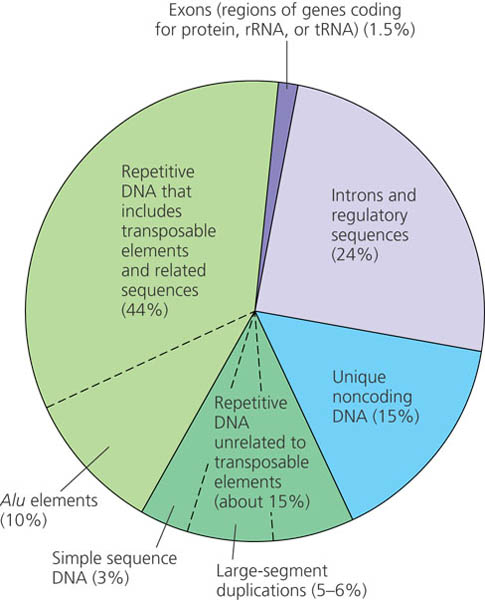Biology Forum › Community › General Discussion › genome
- AuthorPosts
- June 6, 2007 at 4:25 pm #7773
 majik1213Participant
majik1213Participantthe human genome has between 26,000 and 38,000 genes, about which a little over 1% actually codes for protein. Generally speaking, one gene creates one polypeptide. So says one source, but I do have trouble believing this report, because it implies that the human body has roughly 260-380 proteins. Aren’t there more than that?
My questions are:
1) how many proteins does the human body have? (Google was tough to use here for me.)
2) Give an example of a polypeptide that is not a protein.
3) How do you reconcile the number of proteins with the above information (which is regurgitated from an examkrakers MCAT review manual, except for the logical extension that, based on the given information, we must conclude that there are at most 260-380 proteins in the human body). - June 6, 2007 at 5:18 pm #73599
 blcr11Participant
blcr11ParticipantI would question that 1% figure, unless you mean that 1% of the total genome is coding sequence—that is a little more believable. If the genome is ca. 3E9 bases and only 1% were coding, that would be around 3E7 bases of information. If the average gene is, say, 30 kD, that corresponds to around 1E3 bases/gene or around 30,000 genes. For a rough calculation, that puts things in the right ball park.
As to a polypeptide that is not a protein?? I don’t know what you mean; not an enzyme? or not a structural protein? or exactly what? To my mind a polypeptide is, by definition, a protein, be it a small peptide, or F1-ATP synthetase. But maybe you mean “protein” in some special or functional way. In any event, there certainly are more than 260-380 proteins represented in the human genome.
- June 6, 2007 at 5:31 pm #73600
 david23Participant
david23ParticipantHe actually wrote 380 proteins in a "human body". That alone should not be believable. What else does your mcat manual say?
- June 7, 2007 at 4:11 pm #73621
 mithParticipant
mithParticipantA gene by definition codes for a protein… and the number is revised it’s more like around 20,000. A couple of them look like they code for genes but they don’t.
- June 7, 2007 at 5:57 pm #73626
 MrMisteryParticipant
MrMisteryParticipantOk, just a few corrections:
1. Agreed with Dave – The human genome consists for ~21.000 genes.
2. A gene does not necessarily code for a protein. A gene codes for an RNA molecule. It can be mRNA, rRNA, tRNA etc. And because cuaternary structure sometimes more genes code for a protein(ex: 2 genes code for hemoglobin)
Ok, now for your questions:
1. the human body has(and this is a rought estimate, much work remains to be done here) 80000-100000 proteins. You can reconcile this with much smaller of genes if you think of the big picture. For example, a single gene expressed in your brain codes for a large polypeptide that is cleaved and gives rise to the hormone ACTH, MSH, and a beta endorphin. Therefore, in this case, one gene codes for 3 proteins. Another very common phenomenon is alternative splicing: introns are spliced in a different way. Sometimes only parts of introns are removed, and sometimes different segments of a gene are treated by introns to make one polypeptide and as exons to make another polypeptide. Therefore, through this mechanism a gene can generate more than one polypeptide. Another very important phenomenon occurs in lymphocytes(a type of white blood cells). Lymphocytes are the only cells in the human body that reorganise their genomes: they literally cut their DNA and exclude some material from their DNA. This highly complex mechanism, catalysed by a large group of enzymes collectively called recombinase enables one single gene to generate many thousants of different proteins.2. An example is, as I said, one alpha subunit of hemoglobin. Or one beta subunit, whichever you prefer.
3. Already explained.
One last thing: Indeed, only 1,5% of the DNA humans have is made up of exons(either coding for proteins or other RNAs with cellular function). But it is that 1,5%, along with the much longer introns(which make up aproximately 24% of the DNA molecule) make up the 21.000 genes in the genome. The rest of the DNA is made out of what is reffered as non-coding DNA. Non-coding DNA does not code for RNA with a cellular function. This is a very important thing because some transponsable elements(which are catalogued as non-coding) are transcribed into RNA, and some are even translated into proteins. But these RNAs and proteins do not have any cellular function.
Here is a very easy to understand diagram of human DNA. From Biology 7th edition, Campbell and Reece
- AuthorPosts
You must be logged in to reply to this topic.
